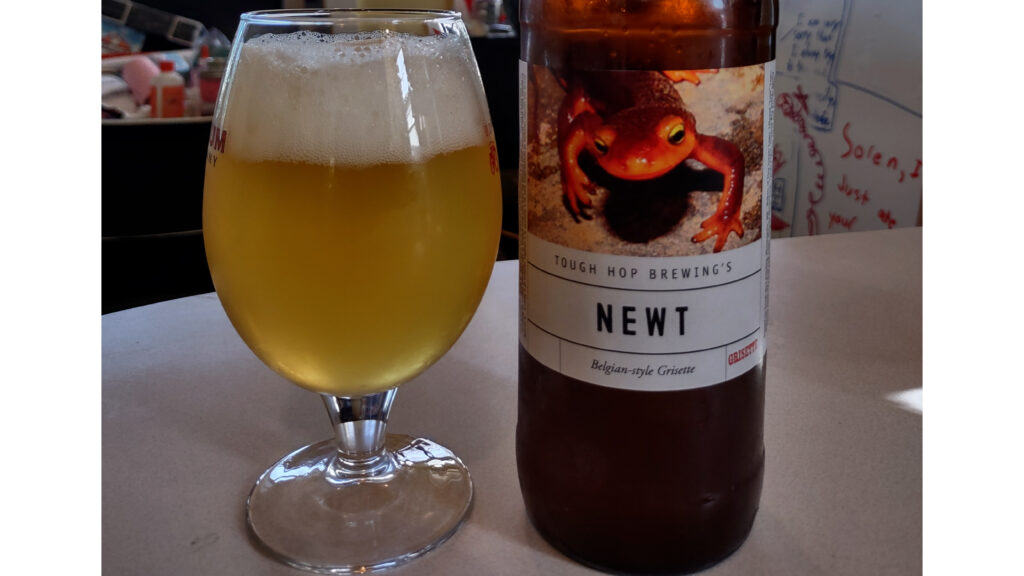
The recipe for “Newt” Grisette: Petite Saison with Lemon was provided to Chop & Brew by Soren Jensen (AKA Tough Hop Brewing), who se homebrewed version won the Best of Show at the inaugural Déjà Brü Homebrew Competition in 2023, the topic of this Chop & Brew episode. As part of being selected BOS winner for the competition, Soren had his beer brewed on a large-scale at Falling Knife Brewing Company in Minneapolis under the name Crucial Taunt Grisette.
Here is a bit of information from Soren on the inspiration for the beer. Also see his Brewer’s Notes below for more on how he co-pitches yeast for this beer (and many others).
I called the beer “Newt” because it was a smaller version of a Saison I call “Salamander.” I won a gold medal with Salamander at the 2022 State Fair. It was inspired by Saison D’Epeautre from Blaugies, a brewery in Belgium. D’Epeautre (and Salamander) has spelt malt in the grain bill, but grisettes always use wheat, so I swapped in white wheat. The one thing that distinguishes a Grisette from a Saison is that a Grisette should always include wheat, while a Saison can include wheat but often does not. Also, a Grisette is always a low alcohol beer, while a Saison can be a low alcohol beer but often is not.
For Newt, I decided to add a little lemon zest and dried peel late in the boil, which is not traditional. But I thought it would add some complexity, and I have been interested in tart Saisons lately. I was going for a tart, dry beer with fruit and spice. It worked out well, though the tartness was pretty mild.
“Newt” Grisette: Petite Saison with Lemon
Batch size: 5 gallons
Pre-Boil Gravity: 1.032
OG: 1.039
FG: 1.003
ABV: 4.7%
IBU: 33
SRM: 2.9
Fermentables
- 5.5 lbs Dingeman’s Pilsner
- 1.25 lbs Rahr white wheat (double crush)
- 8 oz flaked oats
- 8 oz Briess carapils
- 4 oz German Vienna
- 8 oz table sugar
- Rice hulls
Water
- Ca 52, Mg 9, Na 29, Cl 46, So4 101
- 0.5 tablet Campden, 2g Epsom salt, 3g gypsum, 1g salt; 4 ml lactic acide
- Mash Ph: 5.4
- 8.5 gallons water total
- 3.5 gallons strike/mash: 150°F mash for 60 minutes (strike water at 164°F)
- Mash thickness: 1.75
- 5.5 gallons sparge
- 7 gallons in kettle
Boil for 90 minutes. Add table sugar at 10 minutes.
Target 6 gallons post-boil and 5 gallons into fermenter
Hops
- 2 oz Saaz at 20 minutes
- 1 oz Pacific Jade at 10 minutes
Other Additions
- 0.5 tsp yeast nutrient at 10 minutes
- 8 oz cane sugar at 10 minutes
- Zest/peel of 1 lemon + 1 oz dried lemon peel at 5 minutes
- Clarity Ferm at yeast pitch
Yeast
- Wyeast 3711 French Saison + SafAle BE-134, co-pitched (See Brewer’s Notes)
Fermentation
- Pitch at 70°F and let free rise (or force rise) to 78°F and hold until FG. Raise to 82°F for 2 days to ensure completion. Condition one week. Carbonate to 3.5 volumes. (Soren bottle-conditioned his award-winning entries)
Brewer’s Notes
I always co-pitch Saison yeasts and actually most yeasts. I would say that 3711 is my house strain for Saisons and I also use it in many of my pale Belgians. It’s an amazing attenuator and always dries out the beer, which is key. I then pair it with some other strain to get a bit more fruit and spice. BE-134 seems to work quite well. It’s common for me to pitch one slurry and one dry; for example, I recently brewed a British Strong Ale that I co-pitched with Imperial Yeast Juice and 04).)
The background is that a few years ago, when I really got into all grain, I brewed 18 NEIPA’s in a row before giving up. In the end they were good, but not as good as the best. (But I learned how not to oxidize them, which is a good skill.) So I took a break and brewed my first tripel. I was so scared of the high OG that I pitched several different strains. It turned out so good that I stopped making NEIPA’s and switched to Belgians!
Not long after that, I brewed my first Saison, for my very first competition, which was the Iron Brewer competition from Minnesota Homebrewers Association. Again, I used several strains. It won! I got to brew it at Forgotten Star.
